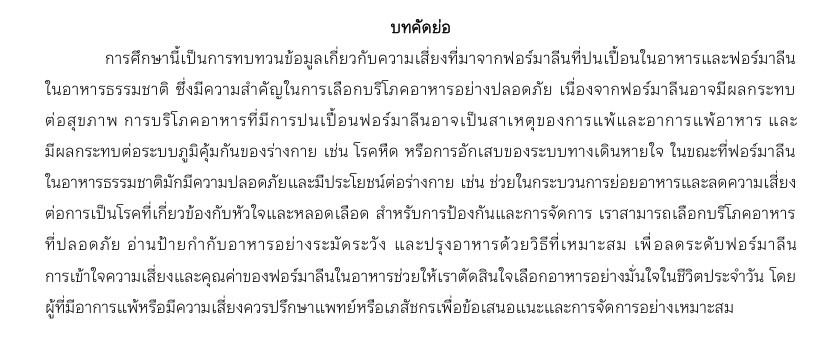Food Contamination with Formalin: Dangers and Solutions
Keywords:
formalin, food safety contaminated, and immune system.Abstract
This article provides information about the risks associated with formaldehyde contaminated food and formaldehyde in natural foods. which is important in choosing to consume food with confidence This is because formalin may have adverse effects on health. Consumption of contaminated formalin can cause allergies and food intolerances. and affects the body's immune system, such as asthma or inflammation of the respiratory system While formaldehyde in natural foods is generally safe and has health benefits, such as aiding digestion and reducing the risk of cardiovascular disease. For protection and management, We can choose to consume safe food. Read food labels carefully. and cook food in the proper way to reduce formalin levels Understanding the risks and value of formaldehyde in food can help us make confident food choices in our daily lives. People who have allergies or are at risk should consult a doctor or pharmacist for recommendations and appropriate management.
Downloads
References
กนกพร ธัญมณีสิน. (2558). ระบาดวิทยาของการปนเปื้อนฟอร์มาลินในอาหารสดในบางจังหวัดของภาคตะวันออกเฉียงเหนือ ปีงบประมาณ 2557. วารสารเภสัชกรรมไทย, 7(1), 31-37.
ธินกร ไฝเพชร. (2563). การตรวจสารฟอร์มาลินในอาหารทะเล บริเวณพื้นที่ตลาด อำเภออู่ทอง จังหวัดสุพรรณบุรี. วารสารสภาการสาธารณสุขชุมชน, 2(2), 26-35.
และบุณฑริกา ทองดอนพุ่ม. (2562). กรณีศึกษาการตรวจหาปริมาณสารฟอร์มาลินที่ปนเปื้อนในอาหารทะเลสดจากตลาดสดในจังหวัดที่ห่างไกลจากพื้นที่ชายฝั่งทะเล วารสารวิทยาศาสตร์บูรพา, 24(3), 1111-1119.
อดุลย์ บุญเฉลิมชัย, กวิสรา กันปี, ธนัชชา ดายัง, นาฎนภา ตันกายา,วารี ทวีปัญญาศาสน์, สวรรยา พงศ์ปริตร
Aminah, A. S., Zailina, H., & Fatimah, A. B. (2013). Health risk assessment of adults consuming commercial fish contaminated with formaldehyde. Food and Public Health, 3(1), 52-58.
Bhowmik, S., Begum, M., & Alam, A. N. (2016). Seasonal variations of formaldehyde and risk assessment of marketed fish contaminated with formaldehyde: fish and food safety issue. In Proceedings of 3rd AFSA conference on food safety and food security, AFSA, India (pp. 15-17) : fish and food safety issue. In Proceedings of 3rd AFSA conference on food safety and food security, AFSA, India. 15-17.
Bianchi, F., Careri, M., Musci, M., & Mangia, A. (2007). Fish and food safety: Determination of formaldehyde in 12 fish species by SPME extraction and GC–MS analysis. Food chemistry, 100(3), 1049-1053.
Claeys, W., Vleminckx, C., Dubois, A., Huyghebaert, A., Höfte, M., Daenens, P., & Schiffers, B. (2009).
Formaldehyde in cultivated mushrooms: a negligible risk for the consumer. Food Additives and Contaminants, 26(9), 1265-1272
Jinadasa, B. K. . K., Elliott, C., & Jayasinghe, G. D. T. M. (2022). A review of the presence of
formaldehyde in fish and seafood. Food Control, 136, 108882.
Jung, H., Kim, S., Yoo, K., & Lee, J. (2021). Changes in acetaldehyde and formaldehyde
contents in foods depending on the typical home cooking methods. Journal of Hazardous Materials, 414, 125475.
Kamruzzaman, M. (2016). Formalin crime in Bangladesh: a case study. European Journal of Clinical and Biomedical Sciences, 2(5), 39-44.
Laly, S. J., Priya, E. R., Panda, S. K., & Zynudheen, A. A. (2018). Formaldehyde in Seafood: A
review. Fishery Technology, 55, 87-93.
Mutsuga, M., Tojima, T., Kawamura, Y., & Tanamoto, K. (2005). Survey of formaldehyde,
acetaldehyde and oligomers in polyethylene terephthalate food-packaging materials. Food Additives and contaminants, 22(8), 783-789.
Qu, M., Lu, J., & He, R. (2017). Formaldehyde from environment. Formaldehyde and cognition,
, 1-19.
Rahman, M. B., Hussain, M., Kabiraz, M. P., Nordin, N., Siddiqui, S. A., Bhowmik, S., & Begum,
M. (2023). An update on formaldehyde adulteration in food: sources, detection, mechanisms, and risk assessment. Food chemistry, 136761.
Tang, X., Bai, Y., Duong, A., Smith, M. T., Li, L., & Zhang, L. (2009). Formaldehyde in China:
production, consumption, exposure levels, and health effects. Environment international, 35(8), 1210-1224.
Teerasong, S., Amornthammarong, N., Grudpan, K., Teshima, N., Sakai, T., Nacapricha, D., &
Ratanawimarnwong, N. (2010). A multiple processing hybrid flow system for analysis of formaldehyde contamination in food. Analytical Sciences, 26(5), 629-633.
Wahed, P., Razzaq, M. A., Dharmapuri, S., & Corrales, M. (2016). Determination of formaldehyde in
food and feed by an in-house validated HPLC method. Food Chemistry, 202, 476-483.

Downloads
Published
Versions
- 2024-08-28 (2)
- 2024-08-28 (1)
How to Cite
Issue
Section
License
Copyright (c) 2024 Nakhon Ratchasima Rajabhat University

This work is licensed under a Creative Commons Attribution-NonCommercial-NoDerivatives 4.0 International License.


